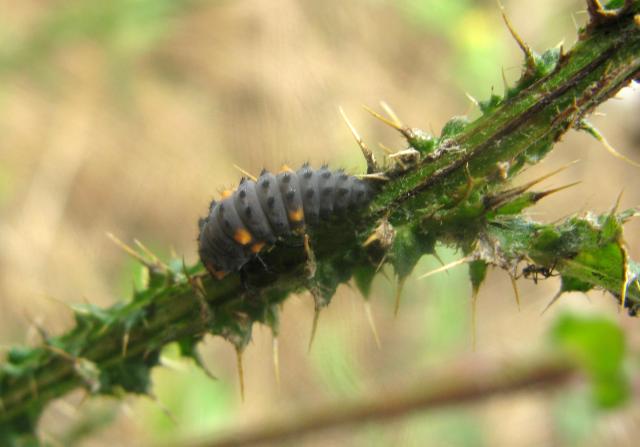This ladybird is very common across Britain. Its elytra (wing coverings) are of a red colour, but punctuated with three black spots each, with one further spot being spread over the junction of the two, making a total of seven spots. Ladybirds are perhaps the most well-known of all British beetles. Both the Adult ladybird and the larvae eat aphids. An adult seven-spot ladybird may reach a body length of 7.6���¢�¯�¿�½�¯�¿�½10.0 mm (0.3���¢�¯�¿�½�¯�¿�½0.4 in). Their distinctive spots and attractive colours are meant to make them unappealing to predators. The larvae are greyish with yellow/orange spots and the pupa and orange colour with black spots. They can be found in a wide range of habitats. Adults overwinter, either singly or in small groups, sometimes along with other species, under bark or among moss and grass. The species can secrete a fluid from joints in their legs which gives them a foul taste. Picture taken 26th July 2011 at Saltmore Farm, Hinxworth.
Added:
6th Apr 2013 by Diane Earl
Subjects:
Biology, Environmental Science
Key Stages:
Foundation, Key Stage 1, Key Stage 2, Key Stage 3, Key Stage 4, Key Stage 4+
Geocode: Saltmore Farm Hixworth
Date of artefact: 26th July 2011
Keywords:
beetle insect invertebrate ladybird ladybug
Related Links:
EXIF data:| FILE |
| FileName | img_1288hxfm267.jpg |
| FileDateTime | 0 |
| FileSize | 3379572 |
| FileType | 2 |
| MimeType | image/jpeg |
| SectionsFound | ANY_TAG, IFD0, THUMBNAIL, EXIF, INTEROP |
| COMPUTED |
| html | width="2463" height="1722" |
| Height | 1722 |
| Width | 2463 |
| IsColor | 1 |
| ByteOrderMotorola | 0 |
| CCDWidth | 4mm |
| ApertureFNumber | f/4.0 |
| FocusDistance | 0.09m |
| UserComment | |
| UserCommentEncoding | UNDEFINED |
| Thumbnail.FileType | 2 |
| Thumbnail.MimeType | image/jpeg |
| IFD0 |
| ImageWidth | 4000 |
| ImageLength | 3000 |
| BitsPerSample | Array
(
[0] => 8
[1] => 8
[2] => 8
)
|
| PhotometricInterpretation | 2 |
| Make | Canon |
| Model | Canon PowerShot G9 |
| Orientation | 1 |
| SamplesPerPixel | 3 |
| XResolution | 1800000/10000 |
| YResolution | 1800000/10000 |
| ResolutionUnit | 2 |
| Software | Adobe Photoshop CS5.1 Windows |
| DateTime | 2011:07:26 21:29:15 |
| YCbCrPositioning | 1 |
| Exif_IFD_Pointer | 292 |
| THUMBNAIL |
| Compression | 6 |
| XResolution | 72/1 |
| YResolution | 72/1 |
| ResolutionUnit | 2 |
| JPEGInterchangeFormat | 1234 |
| JPEGInterchangeFormatLength | 4946 |
| EXIF |
| ExposureTime | 1/100 |
| FNumber | 40/10 |
| ISOSpeedRatings | 80 |
| ExifVersion | 0220 |
| DateTimeOriginal | 2011:07:26 11:10:04 |
| DateTimeDigitized | 2011:07:26 11:10:04 |
| ComponentsConfiguration | ���� |
| CompressedBitsPerPixel | 5/1 |
| ShutterSpeedValue | 213/32 |
| ApertureValue | 128/32 |
| ExposureBiasValue | 0/3 |
| MaxApertureValue | 95/32 |
| SubjectDistance | 9/100 |
| MeteringMode | 5 |
| Flash | 24 |
| FocalLength | 7400/1000 |
| UserComment | ������������������������������������������������������������������������������������������������������������������������������������������������������������������������������������������������������������������������������������������������������������������������ |
| FlashPixVersion | 0100 |
| ColorSpace | 1 |
| ExifImageWidth | 2463 |
| ExifImageLength | 1722 |
| InteroperabilityOffset | 1084 |
| FocalPlaneXResolution | 4000000/291 |
| FocalPlaneYResolution | 3000000/219 |
| FocalPlaneResolutionUnit | 2 |
| SensingMethod | 2 |
| FileSource | � |
| CustomRendered | 0 |
| ExposureMode | 0 |
| WhiteBalance | 0 |
| DigitalZoomRatio | 4000/4000 |
| SceneCaptureType | 0 |
| INTEROP |
| InterOperabilityIndex | R98 |
| InterOperabilityVersion | 0100 |
| RelatedImageWidth | 4000 |
| RelatedImageHeight | 3000 |
 Seven Spot Ladybird (Coccinella septempunctata)
Seven Spot Ladybird (Coccinella septempunctata)

 [ 1 ]
[ 1 ]  [
[

